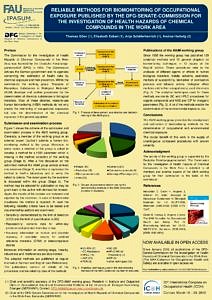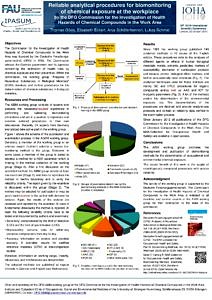Analyses in biological materials
Working group of the Permanent Senate Commission for the Investigation of Health Hazards of Chemical Compounds in the Work Area
This working group develops, verifies, and publishes analytical procedures with which hazardous substances, their metabolites, or characteristic parameters of intermediary metabolism can be determined in human biological materials. The quantification of these substances or parameters is the foundation for “biomonitoring” or “human biomonitoring” in occupational and environmental medicine for the early recognition of potential health risks. Due to its importance in individual prevention, biomonitoring has also been established in relevant legislative ordinances.
Head of the working group
Prof. Dr. rer. nat. Thomas Göen
- Phone number: +49 9131 85-26121
- Email: thomas.goeen@fau.de
Scientific Secretariat
Team E-Mail dfg-aibm@fau.de
Dr. rer. nat. Anja Schäferhenrich
- Phone number: +49 9131 85-26143
- Email: anja.schaeferhenrich@fau.de
Dr. Stefanie Nübler
- Phone number: +49 9131 85-26145
- Email: stefanie.nuebler@fau.de
Secretariat
Team E-Mail dfg-aibm@fau.de
Linda McCargo
- Phone number: +49 9131 85-26120
- Email: linda.mccargo@fau.de
Gabriele Strabel
- Phone number: +49 9131 85-26146
- Email: gabi.strabel@fau.de
The Senate Commission for the Investigation of Health Hazards of Chemical Compounds in the Work Area of the German Research Foundation (MAK Commission) was founded in 1955 and – per their mandate [1] – enacted the formation of the working group “Analytical Chemistry”, which was assigned the task of compiling and/or composing suitable measurement methods for the verification of compliance with limit and assessment values for hazardous substances in the workplace. Among other aspects, these measurement methods included the determination of airborne substances as well as that of hazardous substances and their metabolites in biological materials. In 1972, the working group “Analytical Chemistry” was divided into two parts: “Air Analyses” and “Analyses in Biological Material”, which existed until 2009.
In 2009, each discipline was converted into its own independent working group:
- “Air analyses” working group
- “Analyses in biological materials” working group
The “Analyses in biological materials” working group meets twice a year to confer about the continued development of new and existing analytical methods.
The “Analyses in biological materials” working group develops and verifies analytical procedures for the determination of hazardous materials and their metabolites in biological materials. The methods aim to check for compliance with assessment values in biological materials, which are established for hazardous materials in the workplace (BAT, EKA, BLW, BAR) in order to ensure employee health. To this end, validated analytical methods are necessary to enable a reliable determination of exposure levels within predetermined margins of error.
Alongside the establishment of reliable human-biomonitoring methods for the practical of occupational medicine, the verification and validation of these procedures is of central importance for the assessment of studies in the field of occupational medicine, which are, in turn, cited in documentations for the establishment of MAK and BAT values.
The “Analyses in biological materials” working group further composes framework papers in which important aspects of this field of study are presented and discussed; examples include the suitability of individual analytical techniques for human biomonitoring, new developments in instrumental analysis, the suitability of alternative matrices for human biomonitoring, or aspects of method validation.
The working group is composed of experts from both academia and medical practice who possess the necessary experience in the development and validation of human-biomonitoring methods and who are able to develop, replicate, and independently verify analytical procedures in their laboratories. They serve as working-group members or guests of the Senate Commission on a voluntary basis.
Meaningful collaboration in the Permanent Senate Commission for the Investigation of Health Hazards of Chemical Compounds in the Work Area is codified in our codex, which is signed for confirmation by all experts of our working group.
In order to ensure the scientific independence of all participants, all members and guests of the Senate Commission are required to report conflicts of interests on any agenda items in advance of each working-group meeting. A corresponding declaration on dealing with conflicts of interest is completed and signed by every working-group member and guest before every meeting. Any existing conflicts of interest are openly presented at the start of the meeting, discussed, and recorded as part of the meeting minutes.
The focus area of the working group is the development and verification of analytical procedures for the determination of hazardous substances and their metabolites, which have been evaluated as to their harmful potential and, in some cases, for which an assessment value in biological material (BAT, EKA, BLW, BAR) has been established. The selection of new parameters for which analytical methods are to be developed is carried out in close cooperation with the working-group leadership of the “Establishment of assessment values in biological materials” working group of the Senate Commission. Suitable analytical methods are researched and requested for new parameters, and the working-group is asked whether it has a corresponding analytical method available. If such analytical procedures are not yet available, a method is developed by the group and/or its participants. Furthermore, experts from both academia and medical practice are invited to introduce individual methods or analytical procedures developed in their laboratories into the working group. As a general rule, these procedures and methods must be suitable for reliable workplace monitoring at relevant analyte concentrations. Insofar as the methods enable the reliable measurement of background exposure levels in the general population, they are applicable not only for workplace monitoring but also in the field of environmental medicine for the protection of the general population.
A newly developed analytical procedure is submitted into the working group and comprehensively discussed. At least one method verifier is selected from the working group; this person then replicates the complete procedure in his or her laboratory. This approach to method development by experienced analysts and the subsequent method verification guarantees that only analytically reliable methods are published. Only an independent method verification in an external laboratory can enable a comprehensive discussion and provide necessary information and recommendations for method optimisation.
After successful verification, the method verifier composes a report on the suitability of the procedure. If the analytical method fulfils all necessary criteria, it is adopted by the working group and cleared for publication. The scientific secretarial office of the working group composes a consolidated method manuscript (standard operating procedure), which is then published.
At the regular working-group meetings, the chairperson informs all members and guests of the “Analyses in biological materials” working group on the current status of method publications.
Method manuscripts are subject to a specific structure consistent with the stipulations described in the general chapter “Reliability criteria for analytical methods”. First, the principles of the method are summarily described; this section is followed by a tabular list of the characteristics of the method, e.g. precision, recovery, accuracy, and the limit of quantitation. The following section comprises a comprehensive description of the hazardous substance in question with regard to its physicochemical properties as well as its applications and scientific significance. If available, information on the metabolism and excretion kinetics are included as well as any assessment values in biological materials.
A method manuscript must have the following sections:
- General principles
- Equipment, chemicals, and solutions
- Specimen collection and sample preparation
- Operational parameters
- Analytical determination
- Calibration and calculation of analytical results
- Standardisation and quality assurance
- Evaluation of the method (e.g. precision, accuracy, detection and quantitation limits, sources of error)
- Discussion of the method
- References
Adopted analytical methods are published in both German and English in the MAK‑Collection Online in a timely manner.
Published analytical methods which are no longer consistent with the current state of technology or which possess performance capacity that is no longer sufficient to fulfil the requirement of monitoring compliance with assessment values in biological materials are, upon agreement within the working group, marked as “ÜBERHOLT” (“WITHDRAWN”) and – if possible – replaced by more up-to-date methods.
Publication series
English book series: The MAK Collection for Occupational Health and Safety, Part IV, Biomonitoring Methods, Volume 1–13, Wiley-VCH, Weinheim, Germany; up to Vol. 9 under the title: Analyses of Hazardous Substances in Biological Materials
MAK Collection online: The MAK‐Collection for Occupational Health and Safety, Part IV, Biomonitoring Methods, Volume 1–3, Wiley-VCH, Weinheim – continued online publication of current methods
Alle bisher publizierten Dokumente der AG Analysen im biologischen Material sind sowohl in deutscher als auch in englischer Sprache kostenlos online zugänglich
Articles
Bernhard Michalke, Bernd Rossbach, Thomas Göen, Anja Schäferhenrich, Gerhard Scherer (2015) Saliva as a matrix for human biomonitoring in occupational and environmental medicine. Int Arch Occup Environ Health 88:1–44 doi: 10.1007/s00420-014-0938-5
Thomas Göen, Elisabeth Eckert, Anja Schäferhenrich, Andrea Hartwig (2012) Allocation of reliable analytical procedures for human biomonitoring published by the DFG Senate Commission for the Investigation of Health Hazards of Chemical Compounds in the Work Area. Int J Hyg Environ Health 215:233–237 doi: 10.1016/j.ijheh.2011.08.013
Thomas Göen (2012) Verfügbarkeit zuverlässiger Methoden und Qualitätssicherung für Biomonitoringuntersuchungen. Zbl Arbeitsmed 62:142–146 doi: 10.1007/BF03345051
Posters
Posters
Thomas Göen, Elisabeth Eckert, Anja Schäferhenrich, Andrea Hartwig (2012) Reliable Methods for Biomonitoring of Occupational Exposure published by the DFG Senate Commission for the Investigation of Health Hazards of Chemical Compounds in the Work Area. Poster presented at the International Congress on Occupational Health (ICOH), Cancún, Mexico.
Thomas Göen, Elisabeth Eckert, Anja Schäferhenrich, Lukas Schmid (2015) Reliable analytical procedures for biomonitoring of chemical exposure at the workplace by the DFG Commission for the Investigation of Health Hazards of Chemical Compounds in the Work Area. Poster presented at the IOHA International Scientific Conference, London, England.

